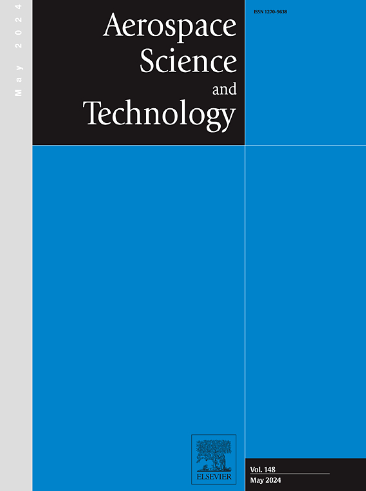Integrated attitude and morphing control for morphing aircrafts: A method to improve aerodynamic efficiency
IF 5.8
1区 工程技术
Q1 ENGINEERING, AEROSPACE
引用次数: 0
Abstract
This article delves into the study of a morphing aircraft characterized by symmetrically adjustable wingspan and sweep angle, proposing an innovative integrated control method for both attitude and deformation. By establishing a hierarchical structure for control tasks, this method allows the aircraft to prioritize and fulfill attitude control (high-priority task) while allocating any remaining control capability to improve aerodynamic efficiency (low-priority task), without negatively impacting the performance of the high-priority task. Firstly, considering the wingspan and sweep angle as auxiliary control variables, the incremental modeling technique is employed to approximate the nonlinear and uncertain longitudinal model of the morphing aircraft with minimal reliance on pre-existing models. Based on these incremental models, a model predictive control strategy is employed to design the attitude control law, ensuring that the aircraft's angle of attack accurately tracks a reference trajectory while satisfying to any input and state constraints. Secondly, with the goal of maximizing aerodynamic efficiency, a morphing control law is formulated. This law incorporates the dynamic consistency principle to enhance aerodynamic performance while simultaneously fulfilling attitude control requirements, thereby achieving seamless integration of attitude and morphing control. Subsequently, closed-loop stability analysis is conducted for the aforementioned control laws using the practical Lyapunov theorem. Finally, numerical simulations are carried out, demonstrating that the proposed controller exhibits robust performance, minimal model dependency, and a notable improvement in aerodynamic efficiency.
变形飞行器姿态与变形综合控制:一种提高气动效率的方法
本文对翼展和后掠角对称可调的变形飞机进行了研究,提出了一种新颖的姿态和变形综合控制方法。通过建立控制任务的分层结构,该方法允许飞机优先考虑并完成姿态控制(高优先级任务),同时分配任何剩余的控制能力以提高气动效率(低优先级任务),而不会对高优先级任务的性能产生负面影响。首先,考虑翼展和后掠角作为辅助控制变量,采用增量建模技术对变形飞机的非线性不确定纵向模型进行逼近,减少对已有模型的依赖;在这些增量模型的基础上,采用模型预测控制策略设计姿态控制律,在满足任意输入约束和状态约束的情况下,保证飞行器的迎角精确跟踪参考轨迹。其次,以气动效率最大化为目标,建立了变形控制律。该规律结合动力一致性原理,在满足姿态控制要求的同时提高气动性能,实现姿态控制与变形控制的无缝结合。随后,利用实用Lyapunov定理对上述控制律进行闭环稳定性分析。最后,进行了数值仿真,表明所提出的控制器具有鲁棒性,最小的模型依赖性,并显着提高了气动效率。
本文章由计算机程序翻译,如有差异,请以英文原文为准。
求助全文
约1分钟内获得全文
求助全文
来源期刊

Aerospace Science and Technology
工程技术-工程:宇航
CiteScore
10.30
自引率
28.60%
发文量
654
审稿时长
54 days
期刊介绍:
Aerospace Science and Technology publishes articles of outstanding scientific quality. Each article is reviewed by two referees. The journal welcomes papers from a wide range of countries. This journal publishes original papers, review articles and short communications related to all fields of aerospace research, fundamental and applied, potential applications of which are clearly related to:
• The design and the manufacture of aircraft, helicopters, missiles, launchers and satellites
• The control of their environment
• The study of various systems they are involved in, as supports or as targets.
Authors are invited to submit papers on new advances in the following topics to aerospace applications:
• Fluid dynamics
• Energetics and propulsion
• Materials and structures
• Flight mechanics
• Navigation, guidance and control
• Acoustics
• Optics
• Electromagnetism and radar
• Signal and image processing
• Information processing
• Data fusion
• Decision aid
• Human behaviour
• Robotics and intelligent systems
• Complex system engineering.
Etc.
 求助内容:
求助内容: 应助结果提醒方式:
应助结果提醒方式:


